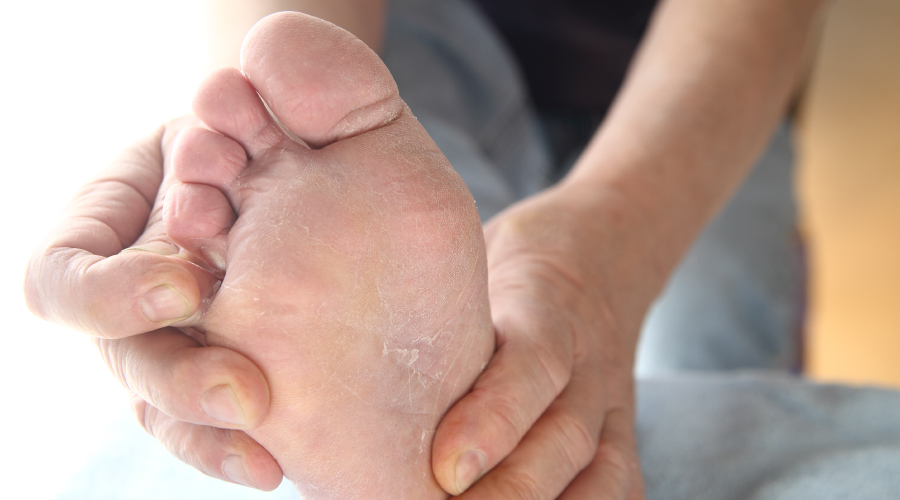

You might have noticed that some people’s feet have peeling and cracking white skin while some have rashes on their feet. Do you ever wonder how the foot skin appears like this and how it can be treated? So, sometimes, when you walk barefoot in an unhygienic place and you have cracks on your skin, the foot bacteria and germs enter inside those cracks and peel which causes foot fungal infections. Another reason for foot fungal infection is when you wear plastic-lined closed shoes which makes your feet moist and warm and fungus thrives. There are a few other reasons as well. Now that we have discussed the reasons that result in foot fungal infection, we will move forward to discussing different types of foot fungus and how to cure them.
Types of Foot Fungus
We have created a list of different types of foot infections. Once you understand the type of foot fungal infection you may be dealing with, you’ll be able to treat it at the soonest:
1. Tinea Pedis or Athlete’s Foot
When you wear tight-fitted shoes, your feet become moist and sweaty, which causes several fungi to grow, including the one linked with ringworm. This results in a fungal infection called Athlete’s Foot. There are different types of athlete’s foot which vary depending on characteristics:
- Toe Web: This foot fungal infection causes itching and flaky skin between the toes where the content of moisture is high.
- Moccasin: This affects the bottom area of your feet, heels, and the side area leading to thick and peeled skin.
- Vesicular or Blisters: Vesicles or blisters filled with fluid develop on your feet, generally affecting the bottom part.
- Ulcerative: When the bacteria enter through the breaks in your feet caused by the athlete’s foot which causes ulcers and swelling with discomfort in your feet.
2. Onychomycosis (or Toenail Fungus)
People with weak immune systems have more chances of having this foot fungal infection and it is usually caused due to prolonged exposure to water, excessive sweating, and many other reasons. It leads to yellow discolouration and scaling on the nails.
3. Ringworm or Tinea Corporis
It is generally caused by the same fungi that infect the Athlete’s Foot and it is transmitted with the contact of any infected area or from one person to another.
4. Jock Itch or Tinea Cruris
It is caused by fungi called Trichophyton and causes drying and cracking of your foot’s skin.
5. Yeast Infection or Candidiasis
Yeast infection is caused by candida albicans and there are four types of yeast infection such as oral thrush, cutaneous, vaginitis, and esophagitis.
Apart from the above-mentioned foot fungus, many other types of foot fungus cause irritation and breakage in your foot skin.
Prevention of Foot Fungal Infections
There are certain preventive measures you must consider to stay distant from fungal infections:
- Keep your Feet Dry and Clean: Always clean your feet thoroughly with soap and keep your feet dry as fungi produce in a moist environment.
- Avoid Tight-Fitted Shoes: Start wearing breathable shoes as tight-fitted shoes create moist environments that attract foot fungal infections.
- Avoid Walking Barefoot: Stop walking barefoot, particularly in locker rooms, public showers, or any unhygienic space as it may cause foot fungal infection.
- Avoid Sharing Personal Items: Don’t share your items with anyone like socks, towels, and shoes.
- Keep your Nails Trimmed: Always keep your nails trimmed as big nails attract nail fungus which may cause problems.
- Avoid Repeating Socks: Never repeat your socks, especially when it’s sweaty as it may be a cause for your foot fungal infection.
Treatment of Foot Fungal Infection
Foot fungal infection treatment can be done in numerous ways, which are as follows:
- Antifungal Creams, Moisturisers, and Ointments: In the treatment of athlete’s foot, you must consider products that contain terbinafine and miconazole and apply them only to the affected area.
- Antifungal Powders and Sprays: You must consider using antifungal powder and sprays if your feet remain moist and sweaty.
- Medicated Nail Creams: There are certain creams and nail polishes designed to penetrate and destroy fungus.
- Application of Baking Soda: Application of baking soda paste on your feet or spraying it will help in absorbing moisture and avoid foot fungal infections.
- Apple Cider Vinegar: Mixing Apple cider vinegar and water in a 1:1 ratio and soaking your feet in it may help keep your feet safe as it has antifungal properties.
- Tea Tree Oil: The application of tea tree oil to the affected area twice may help you in easy recovery as it has antifungal and antiseptic properties.
Conclusion
We have discussed different foot fungal infections that can cause redness, dryness, itching, and peeled and cracked skin, and discussed the ways it can be prevented and treated. It is always suggested that if you observe foot fungal infection symptoms, you should never take it lightly and consult a professional who may help and prescribe you the treatment required.




